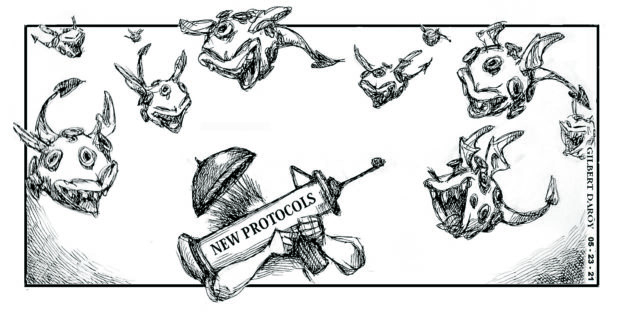Philippine Daily Inquirer / May 23, 2021
Leading health institutions have acknowledged a key finding about COVID-19 that will have a major impact on health protocols and policies worldwide: that SARS-CoV-2, or the virus that causes COVID-19, is airborne.
The World Health Organization (WHO) updated its Q&A page on COVID-19 on April 30, or 15 days after the medical journal Lancet published a commentary detailing 10 reasons that support the hypothesis that COVID-19 is airborne, to note that: “Current evidence suggests that the virus spreads mainly between people who are in close contact with each other, typically within 1 metre (short-range)… The virus can also spread in poorly ventilated and/or crowded indoor settings, where people tend to spend longer periods of time. This is because aerosols remain suspended in the air or travel farther than 1 metre (long-range).”
The US Centers for Disease Control and Prevention (CDC) also changed its science brief on May 7 to reflect the latest findings. Since last year, the WHO and CDC, among others, had advised that the primary concerns for COVID-19 were droplets and surfaces, and objects. But, per the Lancet commentary: “There is consistent, strong evidence that SARS-CoV-2 spreads by airborne transmission. Although other routes can contribute, we believe that the airborne route is likely to be dominant. The public health community should act accordingly and without further delay.”
It listed the following reasons for its conclusion:
Transmission observed at superspreader events, which may be considered as the pandemic’s “primary drivers”;
Long-range transmission observed in quarantine hotels between people who did not spend time in the same room;
Asymptomatic individuals, who account for about 33 percent to 59 percent of transmission, are likely to spread the virus through speaking, which produces thousands of aerosol particles and a few large droplets supporting the airborne theory;
Transmission is higher indoors than outdoors and is substantially reduced by indoor ventilation;
Infections acquired from health care facilities have been reported despite their strict protocols such as wearing mask and PPE;
Viable SARS-CoV-2 has been detected in the air in hospital rooms or cars of infected individuals;
The virus has been found in air filters and building ducts—or locations that could be reached only by aerosols—in hospitals with COVID-19 patients;
Even caged animals have contracted the virus from other infected animals staying in separate enclosures but connected through an air duct;
No study has provided strong or consistent evidence refuting airborne transmission, while contact tracing has shown that conditions such as ventilation play a significant factor in infections;
There is limited supporting evidence that the virus can spread through other means such as objects like clothes or furniture, or through large droplets.
This new development will have to change how governments and health authorities craft policies to combat the virus. Dr. Anthony Fauci, the United States’ top infectious disease expert, said buildings would have to ensure “proper ventilation” and individuals will have to continue wearing masks, especially when indoors and among unvaccinated individuals.
In the Philippines, Dr. Rontgene Solante, head of the adult infectious diseases and tropical medicine department of the San Lazaro Hospital, stressed the need to modify health protocols, particularly in public transport as well as in offices, as employees return to work.
Experts recommend that offices upgrade their heating, ventilation, and air conditioning systems to improve indoor air quality; stagger work shifts; and encourage outdoor meetings. Taking the stairs is deemed safer than riding elevators which can get crowded, and if elevators can’t be avoided, talking is discouraged to avoid the aerosolization of virus particles. Clean indoor air will protect not only against COVID-19 but also other respiratory illnesses.
Among the standard health protocols, physical distancing tends to be ignored the most, which poses a major risk since “an aerosolized droplet can stay in the air longer than the [ordinary COVID-19] droplet and can reach longer than 3 feet—like 6 ft to 8 ft especially in a closed space without ventilation because of their ability to be airborne,” Solante told CNN Philippines. “If you’re in public and in an enclosed space, you’re only wearing a face mask and you’re not practicing 6-foot distancing, that’s the danger of airborne transmission.”
Policymakers and the public alike need to be aware of and to adapt to these new findings quickly, or the virus will continue to afflict more people. Warned Dr. Julian Tang, a clinical virologist and honorary associate professor in the department of respiratory sciences at England’s University of Leicester: “Outdated and unsupported thinking and attitudes can cost lives.”




